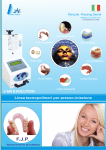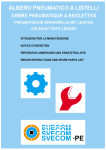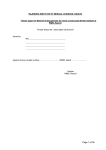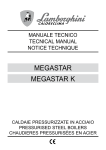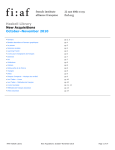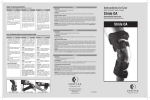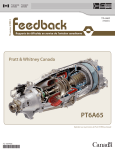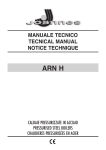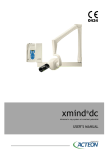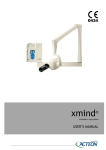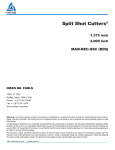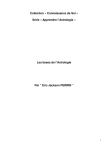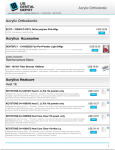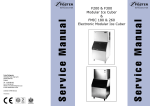Download Injection System J100 EVOLUTION
Transcript
Manual Pressing Dental 2009 (EN) THE J-100 EVOLUTION SYSTEM INSTRUCTIONS FOR USE 8 PRODUCTS AVAILABLE T.S.M. Acetal Dental 1 The.r.mo. Free 2 The.r.mo.Bridge 3 Corflex Orthodontic 4 Corflex Plastulene 5 Conventional hot acrylic resin 6 FLexi-J (Nylon) 7 F.J.P. (Compoud) 8 1 2 3 4 5 6 7 8 What is the J-100 Evolution System? The J-100 Evolution is a multipurpose injection system, with the ability to inject 8 different products, suitable for many different applications: from aesthetic clasps to elastic prostheses, to gum shields for sports activities. In addition, the system allows the user to inject all acrylic resins hot, and to cure them in just 30 minutes, under constant pressure. Ë Ë Ë Ë CONTENTS Multifunctional electronic panel 30 Programs Pre-injection alarm Flask cooling P. 3 Ë TSM Acetal Dental •A Injection of aesthetic clasps •B Injection of middle-sized prostheses •C Injection of larger prostheses P. 4 • Positioning of sprues • Bonding • Staining of TSM Acetal Dental or The.r.mo.bridge Manual operation of the heating chamber P. 6 Ë The.r.mo. Free P. 7 Ë The.r.mo. Bridge P. 8 Ë Corflex Orthodontic • Splints and gum shields for sports activities P. 9 • Injection of Corflex Orthodontic P.10 Ë Corflex Plastulene • Soft base on complete prostheses and obturators Entry into the Program area P.12 Ë Exit from the Program area Program start Program selection Program cancellation Hot Acrylic Resins P.14 Ë Flexi-J (Nylon) • Injection of the Flexi-J P.15 • Finishing and polishing • Repairs and Rebases -Clinical cases P.16 Ë F.J.P. (Compound) P.18 Ë List of product codes The J-100 Evolution Programs Program Temperature Timer 1 Pre-injection Timer 2 Timer 3 °C. Pre-injection Allarm Injection with cooling under heating pressure Ventilation Pressure Injection On / Off Bar speed 01 TSM Acetal Dental “A” 220 °C. 20 minutes ON 02 minutes 20 minutes ON 4,0 Bar Slow 02 TSM Acetal Dental “B” 220 °C. 20 minutes ON 03 minutes 30 minutes ON 4,0 Bar Slow 03 TSM Acetal Dental “C” 220 °C. 20 minutes ON 03 minutes 40 minutes ON 4,0 Bar Slow 04 The.r.mo. Free 220 °C. 13 minutes ON 02 minutes 30 minutes ON 5,0 Bar Fast 05 The.r.mo. Bridge 227 °C. 08 minutes ON 02 minutes 30 minutes ON 5,0 Bar Fast ON 00 minutes 20 minutes ON 4,0 Bar Slow 06 Corflex Orthodontic 165 °C. 20 minutes 08 Corflex Plastulene 80 Sh. 180 °C. 20 minutes ON 00 minutes 20 minutes ON 4,0 Bar Slow 10 Acrilic resin H 150 °C. 00 minutes OFF 15 minutes 15 minutes OFF 3,0 Bar Slow 11 Flexi-J type 1 260 °C. 12 minutes ON 01 minutes 10 minutes ON 5,5 Bar Fast 12 Flexi-J type 2 (or a mix) 265 °C. 12 minutes ON 01 minutes 10 minutes ON 5,5 Bar Fast 14 from 15 to 30 2 D e s c r iption Manually Parameters F. J. P. 230 °C. 15 minutes ON 02 minutes 15 minutes ON 5,0 Bar Slow Free program ex. 220 °C. 20 minutes ON 02 minutes 20 minutes ON -- -- Injection of the T.S.M. Acetal Dental te flon TSM Ace tal Dental Cartridge AESTHETIC CLASP COLOUR SCALE with 20 shades available A - Injection of aesthetic clasps in TSM Acetal Dental After boiling out the wax from the flask, separate the plaster using Pressing Separator. Turn on the J-100, and select the required Program number (see Program chart, above), then press ‘Auto-Start’. Place the required amount and correct shade of Acetal Resin buttons into the aluminium cartridge tube. On top of these, place one or two white Teflon disks. Using the supplied pliers, pinch all the way around the open end of the tube to seal in the buttons. Apply a small amount of Pressing Red Tube Lubricant around the middle of the cartridge tube. Place the cartridge tube all the way into the brass injector cylinder from the unthreaded end, so that the closed end of the cartridge tube sits flush with the threaded end of the brass injection cylinder. Screw the centring adapter into the brass cylinder at the prog. 01 threaded end, and insert the cylinder all the way into the heating chamber. Place the flask so the injection hole fits down onto the cylinder. Slide the vice over the flask, and screw down to ensure a tight grip. The preinjection alarm (if set) will sound 5 minutes before injection begins. Ensure you have the flask in place by this time. Press the ‘Auto-Start’ button once more to silence the alarm. The machine will automatically inject and cool down. When the Program has finished, an alarm will sound, and the machine will shut down. Remove the flask (using a cloth, as it will still be hot), and cool it down by running it under cold water. Deflask, trim using diamond or green stones. Polish with felt wheels and polishing paste. B - Injection of mid-sized prostheses prog. 02 For example: space maintainers with 1 or 2 elements, inlays, pin stumps, splints, etc… Space maintainer Splint Aesthetic clasps Follow the above procedure A, using Program 2, with a pressure of 4 bar. Pin Stumps Onlay Inlay WARNING: Never remove items from a flask while it is still hot. Always wait until the flask has reached room temperature. C - Injection of larger prostheses prog. 03 For example: partial or full plates - temporary bridges – bite raisers – gum shields, etc. Duplicate the master model using silicone, then cast the duplicate in Marble Stone. This plaster has a higher expansion than standard plaster, which will compensate for the larger contraction of Acetal Resin. For cleaner casting, use Gyplux as a separator, instead of Pressing Separator. Place under UV light in the ‘Complex Lux S-8’ light box for 8 minutes. Invest the appliance close to the smaller injection hole (see picture on Page 4). When set, attach wax sprues to each side of the ridge for dentures (5 mm diameter), or for bridges, to each unit of the bridge (3 mm diameter). Follow procedure A, using Program 03, with a pressure of 4 bar, and a slow injection speed (adjustable at the rear of the machine). Orthoptic bite Gingival mask Partial prosthesis WARNING: Never remove items from a flask while it is still hot. Always wait until the flask has reached room temperature. Position of Sprues Ø 4 mm, slightly tapered at the point of contact with the appliance. The wax appliance can be completely submerged in the plaster, up to the edges of the wax, from which the sprues must be connected to the entry of the flask. Full Plates Bite Frameworks Procedure for bonding TSM Acetal Dental to the acrylic using Acelux bonding agent Lower Frameworks Upper Procedure for the staining of TSM Acetal Dental and The.r.mo.Bridge A - In the LaboratorySand-blast the part concerned with 50μ aluminium dioxide. Clean with a steam jet. Apply the Primer Lux Clea (only for TSM Acetal Dental), and allow to dry. Mix the Acelux with the appropriate stain colour. Apply with a brush to the surface. Place under UV light for 2 minutes in the ‘Complex Lux S-8’ light box. When the desired colour is achieved, apply a further layer of Acelux, and place under UV light for a further 7 minutes. A - In the Laboratory Sand-blast the surface with 50μ white aluminium dioxide. Clean with a steam jet. Apply the Primer Lux Clea, and allow to dry. Apply a very thin layer of Acelux, blow off excess product using compressed air to obtain a thin Acelux film. Cure under UV light for 7 minutes in the ‘Complex Lux S-8’ light box. Mini Colour System Staining Kit B - In the Dental Surgery It is now possible to use a composite new-generation adhesive to obtain efficient bonding with TSM Acetal Dental. Preparation should be carried out according to the manufacturer’s instructions. Kit for the staining of acetal and acrylic resins Available versions: Colour System (wooden box complete with 16 stains, code 00300) Vita mini colour system (”Vita” col. shade stain base, code 00299-V) Ivoclar mini colour system (”Ivoclar” col. shade stain base, code 00299-I) USA mini colour system (pre-mixed stain base with ref. Vita, code 00297) Examples of TSM Acetal Dental appliances Before Gum profile after extraction Aesthetic clasps Post core coated with TSM A.D. After Crochet esthétique of the single healing cap Pin stump with diverging roots Space maintainer crochet acétal clasp dentalonsur un squelété Aesthetic framework Bite Raisers Partial prosthesis Active appliance in the oral cavity Injection of The.r.mo.Free Monomer-free acrylic resin for partial or total prostheses View of the sprues for an upper total prosthesis View of the sprues for a lower total prosthesis View of the sprues for a partial prosthesis Invest the waxed up appliance in the flask, using Class III or IV stone, also a Class III or IV plaster is recommended for the model. Run the sprues (ø 5mm) from the injection hole to each side of the appliance, and one to the middle of the appliance. Sprues must extend over the appliance for at least 10mm. Top up the flask. Boil out the wax, apply a first layer of Pressing Separator while the plaster is hot, and allow to cool. Apply a second layer of Pressing Separator once cooled. Fill the aluminium cartridge tube with the required amount of The.r.mo.Free, place the Teflon button on top, and using the supplied pliers, pinch all the way around the open end of the tube to seal in the button. Apply a small amount of Pressing Red Tube Lubricant around the middle of the cartridge tube. Place the cartridge tube all the way into the brass injector cylinder from the unthreaded end, so that the closed end of the cartridge tube sits flush with the threaded end of the brass injector cylinder. Screw the centring adapter into the brass cylinder at the threaded end, and insert the cylinder all the way into the heating chamber. Select Program 04, and press the ‘Start’ button. While the J-100 is heating, close the flask, screwing down the bolts, and place into boiling water, with the open injection hole out of the water. Leave for 10-15 minutes. Place the flask so the injection hole fits down onto the cylinder. Set the injection speed at its maximum (the speed adjuster located at the rear of the J-100 should be completely open). Slide the vice over the flask, and screw down to ensure a tight grip. The pre-injection alarm (if set) will sound 5 minutes before injection begins. Ensure you have the flask in place by this time. Press the ‘Auto-Start’ button once more to silence the alarm. The machine will automatically inject and cool down. When the Program has finished, an alarm will sound, and the machine will shut down. Remove the flask (using a cloth, as it will still be hot), and cool it down by running it under cold water. De-flask, trim using standard acrylic trimmers and polishers. ADVANTAGES: - No free monomer - Excellent adhesion with the same polymer - Excellent adhesion with conventional acrylic resin - Excellent precision fit Note: for re-lines and repairs, use only cold cure acrylic. Injection of The.r.mo.Bridge Acrylic resin for partial bridges and bites Staining Kit Available in 17 shades Including transparent Duplicate the model in silicone, and cast the impression twice (using Class IV plaster). Place the model in the flask, ensuring the vestibular part of the front teeth face the injection hole. Wax up the bridge, invest in a flask, close to the injection hole. Attach the sprues to the incisal edge of all front teeth. For posteriors, place 2 sprues, or more for larger bridges. Sprue diameter should be approx. 4mm, and the length of the sprue from the runner bar should be approx. 3mm. The runner bar and sprues to the injection hole should be approx. 5mm in diameter. Fill the aluminium cartridge tube with the required amount of The.r.mo.Bridge. Add the Teflon button. Apply a small amount of Pressing Red Tube Lubricant around the middle of the cartridge tube. Place the cartridge tube all the way into the brass injector cylinder from the unthreaded end, so that the closed end of the cartridge tube sits flush with the threaded end of the brass injector cylinder. Screw the centring adapter into the brass cylinder at the threaded end, and insert the cylinder all the way into the heating chamber. Select Program 05, and press the ‘Start’ button. While the J-100 is heating, screw down the bolts to lock the flask, top up the flask, and allow to set. Place into boiling water, with the open injection hole out of the water, and leave it for 10-15 minutes. Apply a layer of Pressing Separator while the plaster is hot. Use a compressed air jet to remove excess Separator. Warning: the product The.r.mo.Bridge sticks to plaster, like a conventional acrylic resin. Place the flask so the injection hole fits down onto the cylinder. Set the injection speed at its maximum (the speed adjuster located at the rear of the J-100 should be completely open). Set the injection pressure at 5 bar. Slide the vice over the flask, and screw down to ensure a tight grip. The pre-injection alarm (if set) will sound 5 minutes before injection begins. Ensure you have the flask in place by this time. Press the ‘Auto-Start’ button once more to silence the alarm. The machine will automatically inject and cool down. When the Program has finished, an alarm will sound, and the machine will shut down. Remove the flask (using a cloth, as it will still be hot), and cool it down by running it under cold water. De-flask, trim using standard acrylic trimmers and polishers. During the polishing phase, pay attention not to overheat the material. Staining: Use Acelux, do not use Lux Clea, and do not sand-blast the surface (see page 4). Photopolymerising lacquer Splints and Gum Shields in Corflex Orthodontic The current concept of the tailor-made gum shield The functions of the tailor-made gum shield have evolved considerably since its inception. According to recent studies, in addition to acknowledging its usefulness in preventing dental-maxillary traumas, researchers attribute to the gum shield a fundamental role in preventing brain and spinal column trauma. Dr Poisson (AHU of the UFR of Dentistry of the University of Bordeaux 2, and an expert dentist who works with the French Boxing Federation) has recently published a thesis on the use of gum shields. Analysis of international studies has led towards the determination of a temporal-mandibulary and maxillo-mandibulary relation with regards to the use of gum shields. Dr Poisson’s research paper also proposed a tailor-made gum shield, featuring optimal thicknesses, and a shape that fosters ventilation, even when the jaw is shut tight. This gum shield is manufactured using the high-temperature, highpressure injection technique, with a material called “CORFLEX ORTHODONTIC”. The technique requires a mould to be taken, which allows precise definition of the edges and thicknesses of the gum shield. In addition, the nature of the material used - a copolymer, based on ethylene and vinyl acetate - has for a long time proved its capability to absorb shocks. The results of all these works led to the creation of an individual gum shield that combines mouth ventilation with the ability for the jaw to shut tight, thereby ensuring extreme comfort for athletes. This gum shield, which is effective in preventing dento-maxillary traumas, also plays a role in supporting the head and the neck, increasing cervical muscular activity when athletes move with their jaws shut tight. Therefore, the advantages in terms of endurance - both for the jaw and cervical bones - coupled with an effective ventilation, contributes to preventing brain and spinal column trauma. Within the framework of a Hospital Program of Clinical Research (PHRC), a new set of studies is currently being conducted by the CHU in Bordeaux (Dentistry and Mouth Health Clinic - headed by Professor Dorignac), with the aim of clarifying the mechanism acting on the cervical muscular region when an athlete clasps the tailor-made gum shield in their jaw. The procedure for manufacturing a tailor-made gum shield, established by Dr Poisson, consists of 5 steps (3 in the dental surgery, 2 in laboratory). - STEP 1 (dental surgery) Removal of any prostheses, maxillary and mandibulary impressions taken by the dentist. - STEP 2 (laboratory) Casting of models and preparation of bite registration showing temporal-mandibulary and maxillary relation, and colour chosen for the gum shield. - STEP 3 (dental surgery) Determination of the temporal-mandibulary and maxillary relation, and choice of colour for the gum shield. - STEP 4 (laboratory) Manufacture of the gum shield with high-temperature and high-pressure injection, using CORFLEX ORTHODONTIC. - STEP 5 (dental surgery) Fitting and adjustment of the gum shield, and advice given for its cleaning and maintenance. Injection of Corflex Orthodontic border line 1 Wax up the gum shield. minimum height of 4mm from the edge of the upper incisive at the limit of breathing space Ventilation space Colour scale 10 shades available 2 Invest in flask with an 8mm diameter injection canal. 4mm minimum 3 Profile of the gum shield. Advice for the perfect trimming of your gum shield or positioner. 4 After boiling out the wax, allow the mould to dry, and then to obtain a gloss surface, apply a film of light curing resin Gyplux, and place in a UV light box for 8 minutes. 5 Cool the flask down to room temperature, then inject the Corflex Orthodontic (Program 06). Calibration spheres After trimming the device to the desired thickness and shape, use the felt polishers from the Poly–Corflex kit to obtain a satin finish. Use a flame to obtain a smooth and shiny surface, or alternatively use a recommended solvent. Leave the device in water for at least 10 minutes. Note: At the end of the Program, check that there is still some material left in the cartridge. If there is not, then insufficient material may have been used, so we recommend re-injecting with some additional material in the hot flask. Injection of Corflex Plastulene Placing Plastulene 80 Shore A into the flask For the manufacturing of soft bases on total prostheses, or surgical obturators Once wax modelling has been completed, and after performing the final test, define the height forecast for the Plastulene with a wax thread of a different colour (fig. 1). Place the prosthesis in the first part of the flask, paying attention not to cover the wax thread (fig. 2). Insert the metal thickness between the two parts (code RJ-100 739). Cast the impression. Boil out the wax. Make 2 x 6mm sprues at the level of 36/37/46/47 (fig. 3). Separate with Gyplux and cure in a light box for 8 minutes. Press and bolt the flask. Cure under UV light in a light box, and then, starting with cold water, heat it until it reaches boiling temperature (100°C), and allow to boil for 30 minutes. Before this time expires, prepare a cartridge with 2-3 Plastulene cylinders and Teflon caps. Lubricate the cartridge externally, and place it into the brass cylinder, screwing the centring device with the thermoinsulating washer. Use Program 08 of the J-100 Evolution, at 4 Bar. Pre-heat the cartridge for 20 minutes at 180° C. The separator must be used during all the working phases, up to the removal of the silicone spacer. Roughen the surface of the teeth, and separate as usual. Remove the flask from the boiling water, open it using thermo-insulating gloves. Rapidly remove the Teflon sheet, any residues of foglio R (sheet R) and the “silicone” spacer, and clean the sprues well, so that no plaster residues remain. Bolt the flask shut. Placing the spacer: we recommend using silicone SilLabor 95 Shore to make the spacer, which is required to keep the space that must be obtained afterwards with the Plastulene. Alternatively, a thermoformed sheet, 1mm thick may be used, leaving the areas of the retromolar trigones free (picture B page 11). All the phases described above must be performed as fast as possible, to prevent the flask from cooling; otherwise there would be a loss of the heat required to aid adhesion of the two materials. Fill the sprues with silicone and keep under pressure until the silicone has hardened. Prepare the acrylic resin, e.g. Idobase or Meadway (the type of resin is very important, in order to obtain a better binding with the Plastulene). When the resin has reached the right density, press it onto the spacer. Place under a hydraulic press, about 2.5 bar. Press for 2-3 times until the exceeding amount has been totally removed. Put a small amount of resin (discarded from the first pressing) on the back area, to increase resin density. Spread the 128 adhesive evenly on the resin and let the solvent evaporate for 3-4 minutes. You will notice that the superficial layer is no longer bright. Place the sheet “R” (Plastulene) onto the Adhesive 128 Inject the flask, and allow to cool under pressure for about 1 hour, until the heating chamber temperature reaches 40°C. Take out the flask and place in cold water for 10-15 minutes, before opening it. Roughen and trim the resin as usual. For Plastulene, use Poly-corflex felts (page 11). For the trimming of edges, Corflex Polish may be used, whereas for polishing, the flame should be used, with care. Note: in the case of a very thin crest (knife blade), we recommend adding two additional sprues, running behind the retromolar spaces and connecting them at the level of 36-37-46-47. Examples of Preparation Phases A Definition of the Plastulene edge height with the aid of a wax thread Example of a thermo-formed spacer, 1mm thickness, leaving the retromolar spaces free Instructions for the cleaning and maintenance of Corflex Plastulene Clean the surfaces daily and gently with a toothbrush, using a toothpaste and cold water (< 42°C). Never use effervescent tablets to clean the prosthesis. Never use soaps or detergents, or other detergent products. Recommendations: - If you notice abnormal tartar deposits on the prosthesis, take it to your dental technician for cleaning. - We recommend using a small ultrasound device for daily cleaning. - If you notice a little colour change on the surface of the material, this may be caused by the mouth pH (acidity), or dyes contained in coffee, in tea, tobacco, etc. These possible marks do not affect in any case the physical properties of the material, or its endurance. Poli-Corflex felts for the finishing of Plastulene edges Procedure for the injection and curing of conventional type hot acrylic resins After waxing up, invest as usual, with the posterior region of the denture facing the injection hole. After the plaster has set, clean and smooth the surface, then place injection sprues of 8-10 mm diameter. Place an outlet sprue of 4 mm, ending within the plaster. After boiling out the wax, roughen the surface of the teeth to increase retention. Apply separator (e.g. Separating Pressing) to the plaster, first while the surface is hot, then after it has cooled. Bolt the flask, and place the flask in boiling water for 15 minutes, leaving the injection hole out of the water. Set the J-100 Evolution to Program 10, adjust the pressure to 3 bar, and start manual heating by pressing the ‘Heating On/Off’ button (NOT the ‘Auto Start’ button) and heat to 150°C. 4 Mix the acrylic as normal, to a dough-like consistency. Roll into a sausage shape, and place into the brass tube used for acrylic injection. Screw on the centring adapter, and place a brass button with a rubber seal into the open end. A20 AOR2 A19R AOR1 40 TA 40 TAOR 14F1OR 6 With the J-100 at 150°C, quickly place the brass tube into the heating chamber. Slide the vice over the flask, and screw down to ensure a tight grip. Close the door and inject the product by pressing the ‘Piston Up’ button, followed by the ‘Auto’ button. The J-100 will remain at 150°C for 15 minutes, then a cooling phase will follow for a further 15 minutes (until end of cycle). Take the flask out, and allow to cool to room temperature. Unscrew the centring adapter, place the brass tube in cold water, and then use the blue tube to press out the residual resin. Trim as normal. NOTE: Using a Type 200 flask (code 00025), it is possible to inject and cure two prostheses at the same time in just 30 minutes. It is possible to inject and cure all acrylic resins in the J-100 Evolution. Assessment of precision Rapid finishing CONCLUSION Using the J-100 Evolution injection system generates superior results when compared with the conventional pressing method. ? ? ? ? superior mechanical resistance no raised bite, with a more compact resin superior dimensional stability no porosity ex. of acrylic resin Injection of Flexi-J the flexible prosthesis Excellent colour matching colours are very similar to those of natural gums Flexi-J colour scale 7 shades available including transparent Wax up the appliance on the duplicated model. Drill the retention holes on the teeth while setting up. Place into the flask with the rear part facing the injection hole. The sprues must have a minimum ø of 5mm, and must be placed on the posterior region of the prosthesis, connecting them to the injection hole. Top up the flask with class-III or IV plaster. Fill the aluminium tube with the required amount of Flexi-J, and place into the machine to dry at 90°C for 45 minutes, without using a Teflon button. It should be dry by the time you top up the flask and boil out the wax. Boil out the wax, apply Pressing Separator or Gyplux, and then cure in a UV light box for 8 minutes. Gyplux will make the surface of the resin smoother after injection. If the teeth become loose after boiling out the wax, re-affix them with glue. Before it cools, place a Teflon and brass button (code A-21) into the aluminium tube. Pinch the end of the cartridge with the pliers, and put it into the brass cylinder, and into the J-100, with the threaded end of the aluminium tube protruding 2-3 mm. out of the brass tube. Screw the centring adapter into the insulating part (code a-20 IC+II). Adjust the J-100 to maximum injection speed (the adjustment screw located at the rear of the J-100 should be completely open). Set the J-100 to Program 11 or 12, with a pressure of 5 bar. Press the Manual Heating On’ button. When the temperature has reached 255°C, place the brass tube into the J-100 and start the Program. The cold flask must be placed in the heating chamber 5 minutes before injection. It is possible to use the pre-injection Program to sound an alarm when it is time to place the flask. At the end of the cycle, take the flask out of the J-100, allow to cool, and break off the brass tube from the flask. Open the flask only when it has reached room temperature. Procedure for trimming and polishing with Flexi-J TRIMMING 1 Use green silicone carbide stone for resin, at a slow speed (1000-1500 rpm), so as not to overheat the product. 2 Use silicone polishers for pre-polishing to obtain a smooth appearance. 3 Use a scalpel to trim thin edges. POLISHING TO USE THE SPEEDS BRUSHES' REDUCED Super Polish Use polishing brushes with plenty of pumice to keep the product cool. For high gloss, use a hi-lustre polishing compound. New universal polishing paste for the F.J.P. resin. It can be used also with all nylon bases resins. Polisonix Indispensable for the cleaning of Flexi-J Procedure for repairing or re-lining with Flexi-J It is necessary to follow the traditional procedure and place the prostheses into the flask, with the parts to reconstruct remodelled using wax. Then clean the flask according to the known technique. Make the surface of the Flexi-J rough in the area concerned, to increase mechanic retention and ensure a good adhesion with the new material that shall be injected. Insulate with Gyplux lacquer and polymerise for 8 minutes. Prepare the cartridge with the material needed and start the programme of J-100 Evolution (see page 14, point 4). Leave the boiling hot flask open for about 4 minutes, to allow the product Primer Flexi-J time to act; Close the flask, place it on the injector and inject the new material. Put in boiling water the flask containing the device in Flexi-J that has to be repaired or rebased.. Take the flask out of boiling water 7 minutes before injection, remove the water residues using compressed air. Spread Primer Flexi-J “P” on the whole surface that has to be repaired or rebased. (Note: the product must not be placed on teeth) Flexi-J Clinical Cases LABORATOIRE GAVALDA (ALBI) BEFORE AFTER LABORATOIRE CHAUVIN (LA CROIX FALGARDE) BEFORE AFTER ADVANTAGES OF FLEXI-J (Nylon) Natural Translucency Monomer-Free Lightness and Flexibility Virtually Unbreackable No metal clasps Exellent colour matching to natural gums Ability to add or repair elements DENTAL CONCEPT MÉDITERRANÉ (NICE) AFTER Crochet esthétique LABORATOIRE GAVALDA (ALBI) LABORATOIRE IMPACT DENTAIRE (NICE) BEFORE BEFORE AFTER AFTER Crochet esthétique Flexi-J Clinical Cases LABORATOIRE IMPACT DENTAIRE (NICE) LABORATOIRE GAVALDA (ALBI) DENTAL CONCEPT MÉDITERRANÉ (NICE) BEFORE BEFORE BEFORE AFTER AFTER AFTER New F. J. P. The Innovation The thermoplastic injection resin F. J. P. is the result of years of research and experimentation led by Pressing Dental of San Marino. For many years, materials based on Polyamide (nylon) have been used in the manufacturing of prostheses, such as “ Val-plast” (by Val-plast, USA), “ Flexite “ (by Flexite USA) and Flexi-J, produced by Pressing Dental. The success of these materials is due to the mechanical properties of the resin, resulting in great comfort recognized by patients, and most of all, an excellent aesthetic result. Starting from the basis of these products, and being aware of their limits, Pressing Dental has created a compound that improves their features, while maintaining the same advantages. Objective Creating an alternative compound to nylon, with these features: Moderately elastic Low liquid absorbing (one third of nylon) Adhesion with acrylic resin (by using a primer) No after-fusion bubbles, even with remarkable thickness Can be polished with conventional techniques Reusable (if used with J-100 and J-200 Pressing machines) Procedure for the injection of F.J.P. resin Code: A, B, C, D, E – 00900 - Program 14: Temperature °C. : 230 °C Timer 1 pre-injection: 15 Min. Timer 2 injection with heating ON: 02 Min. Timer 3 Cooling under pressure: 15 Min. Ventilation: ON Pressure: 5 bar Injection speed: Slow Semi-transparent No need for exsiccation High precision Easy processing Good colour stability Sterilize at 120 C. Super Polish New universal polishing paste for the F.J.P. resin. It can also be used with all nylon- based resins. List of products codes Flasks Type 50 COD. 00030 Type 100 COD. 00020 COD. 00050 Tube lubricant type red Rj100 0018A Screw for flasks Type 200 COD. 00025 A-20 II Thermal washer for J-100 Evolution Centring device A-20 IC with insulating part A-20 II + A-20 II 2 Mini colour system System for the staining of acetal and acrylic resins Light curing trays (50 pieces) COD 14001 Neutral COD 14002 Pink COD 14003 Blue Insulating washer for J-100 Evolution +reinforcing element A-19 Injector for thermoplastic resins (e.g. TSM Acetal Dental) RJ100-0014 G1 +G2 for J-100 (mod. ‘95) 00040 Tube type J-100 (containing 60 tubes + 60 caps) 00041 Tube type J-100 (containing 75 tubes) 4 Neon, type 71 Halogen Es. 00800 B Resin Flexi-J colour B(Nylon) 4 Neon, type 78 Teflon cap Metal cap A-21 (indispensable for Flexi-J) 00040 T Complex Lux S-8 Universal light curing lamp (320/550 NM) Pneumatic drill for bolting flasks Filwax White Wax for channels Available Ø2, 3, 4, 5, and 9 mm. COD 00082 Acecril Chemical bonding of TSM Acetal Dental and acrylic resins COD 00302/2 Lux Clea 2x10 cc. Primer for Acelux COD 00095 Acelux 30 cc. 000301/2 2 x 10 cc. COD 00090 Gyplux 30 cc. 00091 Gyplux 50 cc. Light curing lacquer for the staining of TSM Acetal Dental Light curing insulating material for plaster models Sil- Labor Polycondensation elastomer silicone Type classic and hard 85 and 95 shore A Sil- Labor “Gemini” Addition silicone 1 : 1 Type 82 Sh.A colour Pink Type 90 Sh.A colour Light blue COD S-500 Separating Pressing Special insulating material. Contents: 500 ml COD 00084-E Marble Stone (Evolution) Special plaster for TSM Acetal Dental models Contents: Kg. 3 COD E-M Expomodel 500gr.+100 gr.B Sil- Press Addition silicone 1 : 1 Type 10, 21 or 28 shore A A simple solution for your exhibition moulds Epoxy Resin compound And more...... see details on the web-pages or ask to the Pressig Dental dealer. List of Product Codes The compete range, see the web pages T.S.M. Acetal Dental – Thermoplastic resin – 1 Aesthetic clasps, space maintainers, bites, partial prostheses, etc. 2 Code. 00549 T.S.M. Acetal Dental Colour scale Code. 00550 Assorted package, 1.150kg divided in 20 colours (8 disks per colour) + colour scale Code. 00551-00570 500gr package ref. “Vita” A-A1-A2A3-A4-B-B1-B2-B3-B4-C1-C2-C3-C4-D2-D3-D4 pink F1-F2-F3 Code. 00313 Colour system replacement - Magenta Red for gum colouring Code. 00084E Marble Stone Evolution, 3kg package Code. 00095 Acelux, 30 cc package Code. 00301/2 Acelux, 2 x 10cc package Code. 00302/2 Lux Clea, 2 x 10cc package Code. 00300 Colour System, complete wooden box: 16 pigments – white, black, yellow, Magenta red, cyan blue, purple, green, orange, neutral brown, reddish brown, opaque grey, translucent grey, blue translucent grey, ochre, red orange, red purple + Acelux 10ml, Lux Clea, 2 brushes and mixing plate Code. 00299-I Mini Colour System “Ivoclar" base Code. 00299-V Mini Colour System “Vita" base Code. 00299-USA Mini Colour System with premixed pigments on “Vita” base The.r.mo.Free – Thermoplastic acrylic resin – Acrylic resin for prostheses without liquid monomer Code. 00649 The.r.mo.Free and The.r.mo.Bridge Colour scale Code. 00601 Transparent colour, 500gr Code. 00602 Pink colour without fibres, 500gr Code. 00603 Pink colour with fibres, 500gr 3 The.r.mo. Bridge - Resin acrylic thermoplastic Code. 00649 The.r.mo.Free and The.r.mo.Bridge Colour scale From Code: Code. 00650 to 00666 200 gr. package - colours: 00650 transparent, 00651 to 00666 ref. Vita base A, A1, A2, A3, B, B1, B2, B3, C, C1, C2, C3, D, D2, D3, D4 Monomer-free acrylic resin for temporary bridges, bites, etc. 4 Corflex Orthodontic (type 80) - Resin vinyl thermoplastic - Resin for positioners and gum shields for sports 5 Code. 00997 Colour scale Code. 01000 Assorted package, 600gr (excluding colours black and white) 400gr packages Code. 01001 Transparent Code. 01002 White Code. 01003 Yellow Code. 01004 Green Code. 01005 Pink Code. 01006 Red Code. 01007 Fuchsia Code. 01008 Light Blue Code. 01009 Blue Code. 01010 Black Corflex Plastulene (type 80) – Thermoplastic vinyl resin – Code. 01001 Single colour pink, 200gr package Code. K Teflon sheets 30pcs package Code. R-sheets Plastulene sheets, 10 pcs package Code. 00085 Poly-Corflex (felts for the finishing of Corflex vinyl resins), 11pcs package Resin for “soft” bases on total prostheses and surgical obturators “IDO Base” – Acrylic resin for direct polymerisation on the J-100 Evolution – 6 Conventional hot acrylic resin with polymerisation after injection This product is available only upon request Code. 21397 Idobase polymer, 900gr Code. 21398 Idobase monomer, 500ml Spare O-ring for injection kit for acrylic resins O-ring for centring device /acrylic OR1, 10 pcs Code. RJ100 A Or1 O-ring for centring device /acrylic OR2, 10 pcs Code. RJ100 A OR2 Code. RJ100-0014 F1 OR O-ring for conventional centring device, 10 pcs. O-ring for centring device /acrylic cap 00040TA, 10 pcs Code. 00040 TA-OR Flexi-J (Thermoplastic nylon resin) - 7 8 Resin for flexible prostheses F. J. P. (Compound) Code.00799 colour Scale Code.00900-A F.J.P. white/transparent colour (250g Packungen:) Code.00900-B F.J.P. pink colour Code.00800-A Type 1 white/transparent colour Code.00800-B Type 1 pink colour Code.00800-C Type 1 pink colour Code.00800-D Type 1 pink colour Code.00800-F Type 2 transparent colour Code.00800-G Type 2 pink colour Code.00800-H Type 2 pink colour Code.00800-P Flexi-J Primer adhesive for polyamides Accessories and spare parts Code. Rj100-0014 F1 Code.RJ100-0014 F1 OR Code. RJ100-0014 G Code. RJ100-0014 G1 Code. RJ100-0014 G2 Code. RJ100-0013 A Code. RJ100-0101 Non-insulated centring device J-100 mod. 95 O-ring for centring device (J-100 mod. 95 and Evolution), 10 pcs Insulated centring device (J-100 mod. 95 – insulating part not included) Insulating part for centring device mod. 0014G (J-100 mod. 95) Reinforcing ring for insulating part 0014g1 (J-100 mod. 95) Flask-locking knob Complete solenoid valve unit (J-100 mod. 95) Code. A-20 Code. A-20 IC Code. A-20 II Code. A-20 II 2 Code. A-19 Code. A-19R Code. RJ100-0103 Non-insulated centring device J-100 mod. Evolution Insulated centring device J-100 mod. Ev. (insulating part excluded) Insulating part for centring device mod. A-20IC Reinforcing element for insulating part A-20II Tube Container – injection mod. J-100 Evolution Tube Container for acrylic resin mod. J-100 Evolution Pressure control unit (J-100 mod. 95) PRESSING DENTAL SRL is a company constantly looking for innovative materials and techniques, with the aim of replacing acrylic resins and metals with advanced technopolymers. All our products are clinically tested and certified according to Rule 93/42. The production quality of materials and their traceability are guaranteed in conformity with UNI EN ISO 13875.2004. Over 80 scientific publications confirm the validity of products and injection systems of the J-100 and J-200 Evolution range. The products manufactured by Pressing Dental have long been present all over the world, including: the US, Canada, Argentina, Mexico, Brazil, Dominican Republic, Korea, Thailand, the Philippines, Egypt, Morocco, Russia, Belorussia, Ukraine, Estonia, Germany, the Netherlands, Belgium, Poland, Luxembourg, England, Croatia, Switzerland, Spain, Italy, Portugal, Israel, Syria, etc. ? SIMPLER ? CHEAPER ? MORE ERGONOMIC The J-100 Evolution is the most complete pressure-injection system, as acknowledged by thousands of users. PRESSING DENTAL Srl Via Edoardo Collamarini 5d, 47891 Dogana (Repubblica di San Marino) Tel dall’Italia 0549 909948 - fax 0549 909958 From other countries Tel++ 378 909948 - fax ++ 378 909958 [email protected] www.pressing-dental.com Elaboration in collaboration with Thank’s to Dr. Poisson and Prof. Dorignac (s. 8-9) for theirs precious collaboration, also to Labors Gavalda, Chauvin, Impact Dentaire, Dental Concept Méditerranée and Rohr (S. 16-17). Cod. 098053 / ENG Rev. 1 I.P. It is the only injection system that can be used with 7 thermoplastic and acrylic materials. 0546





















